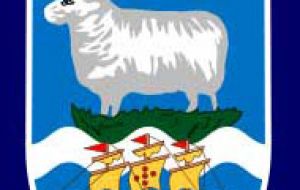MercoPress. South Atlantic News Agency
Falklands’ Day celebrated on 14 August remembers first recorded sighting by John Davis in 1592
 John Davis the English explorer and his vessel ‘Desire’
John Davis the English explorer and his vessel ‘Desire’ Falkland Islands Day was celebrated last Wednesday 14 August with a reception at Government House in Stanley hosted by Governor Nigel Haywood. The date marks the first recorded sighting of the Falklands on 14 August 1592 by English explorer John Davis who captaining the 120-ton vessel ‘Desire’ in that month was blown by a storm into ‘certaine Isles never before discovered’. Davis account was published in 1600 in London by Richard Hakluyt.
Some of the families with the oldest links to the Falklands were invited to the reception to honour the occasion followed by a brief speech from the Governor.
At the end of the speech Governor Haywood proposed a toast to the Falkland Islands.
The Falklands’ coat of arms motto is precisely “Desire the right” in honour to Davis and includes an image of his vessel ‘Desire’.
According to the brief history of the Falklands, Davis was followed by the English seaman Sir Richard Hawkins in 1594 and the Dutch explorer Sebald de Weert who visited in January 1600. The first recorded landing on the uninhabited islands took place on West Falkland on 27 January 1690, when the English sea captain John Strong came ashore.
For many years in the European continent the Falklands were known as the ‘Sebaldines’ in honour of the Dutch explorer Sebald de Weert.
Strong named the passage between the two Islands ‘Falkland’s Sound’ and Lord Falkland’s name later became attached to the entire main Islands group. In the early eighteenth century French sailors from the port of St Malo gave their name to ‘Les Iles Malouines’.
More than half a century later, in the 1760s, two settlements were established in East and West Falkland almost simultaneously by two different countries.
The French nobleman Louis Antoine de Bougainville, in a brief chapter of his remarkable life, landed settlers who had left Nova Scotia after the British conquest of French Canada at Port Louis in East Falkland in 1764.
In January 1765 Admiral Byron landed at Saunders Island north of West Falkland and claimed the isles for the crown of Great Britain. A second British expedition in 1766 returned to Saunders and named their settlement Port Egmont. They built houses and a prefabricated blockhouse and planted gardens.
Although British and French colonists became aware of each other’s activities relations were polite, helped no doubt by the distance between Port Louis and Saunders Island.
But in 1767 Bougainville was obliged to sell his settlement to the Spanish crown, which resented a foreign colony in what it considered its sphere of influence.
The Spaniards took over Port Louis which they named Puerto de la Soledad. Keen to assert their authority, a Spanish fleet arrived at Saunders Island in 1770 and obliged the small British garrison to leave. An international crisis followed, which was only resolved in 1771 when Spain agreed that the British settlement should be restored and three ships sailed out to re-establish British authority in September 1771.





Top Comments
Disclaimer & comment rules-

-

-

Read all comments...and they remain British to this day!
Aug 19th, 2013 - 07:39 pm 0...and they lived happily ever after.
Aug 19th, 2013 - 09:41 pm 0:-)
You'd have thought they'd mention his stirling rugby career too.
Aug 19th, 2013 - 10:32 pm 0Commenting for this story is now closed.
If you have a Facebook account, become a fan and comment on our Facebook Page!